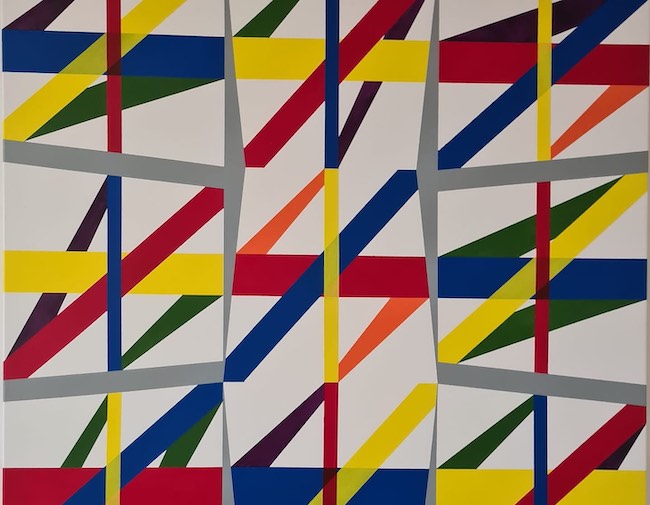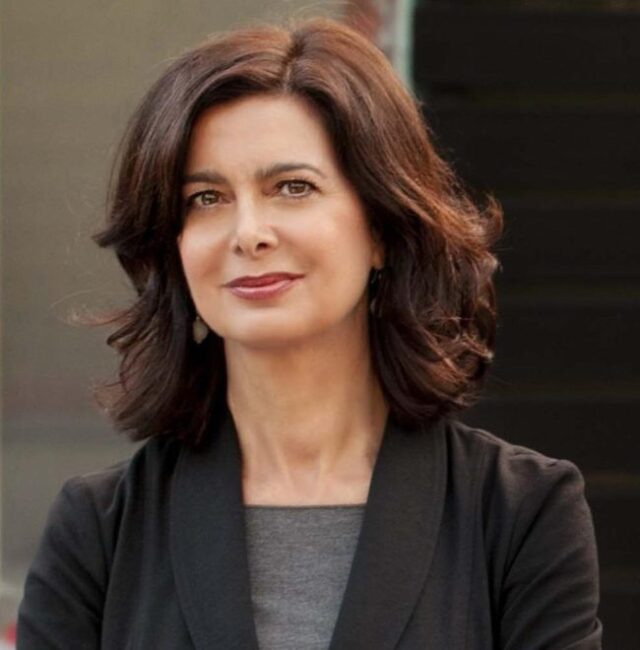La poliedricità dei punti di vista e degli approcci nei confronti della vita e delle circostanze che si susseguono contraddistingue la società contemporanea tanto quanto il fulcro di osservazione degli artisti che all’interno di questa modalità esistenziale si muovono per la propria ricerca espressiva, assecondando lo stile e il linguaggio pittorico e scultoreo alla modalità più affine al loro modo di concepire la realtà circostante. Alcuni mostrano l’esigenza di distaccarsi fortemente dall’osservato per inoltrarsi in un mondo più rigoroso, più scientifico quasi, da cui tuttavia non può fare a meno di fuoriuscire una natura aperta e positiva, che proprio in virtù di quella purezza plastica, riesce a evidenziare tutta la morbidezza del possibilismo. L’artista di cui vi parlerò oggi appartiene a questa categoria di creativi.
Il percorso di sperimentazione attraversato dall’arte nel corso dei primi decenni del Novecento è stato contraddistinto da separazioni nette e ben definite tra quel gruppo di artisti che pur apportando modifiche concettuali, desiderava in qualche modo restare legato alla figurazione, all’osservato eventualmente da trascendere per essere assecondato alle linee guida dei movimenti a essi cui appartenevano, e quelli che al contrario sottolinearono la necessità di affermare una superiorità del gesto plastico su qualsiasi forma riconducibile alla realtà quotidiana e a tutto ciò che l’occhio poteva cogliere intorno a sé, determinando così la nascita coraggiosa di tutte le correnti artistiche che tendevano verso l’astrazione, l’indefinitezza delle forme e la rigorosità schematica. A parte un breve preludio con l’Astrattismo Lirico di Vassily Kankinsky, il cui carattere emotivo sarà ripreso qualche anno dopo e ampliato dagli esponenti dell’Espressionismo Astratto, la tendenza verso l’indefinitezza fu alla base di movimenti come il Suprematismo, di cui il fondatore Kazimir Malevic è considerato anche anticipatore e ispiratore dell’appena successivo De Stijl. Questo movimento nato in Olanda dalle linee guida del suo ideatore Piet Mondrian, affiancato da Theo van Doesburg, estremizzò la geometricità del Suprematismo e si spinse fino ad accettare solo le forme del rettangolo e del quadrato, le linee dritte orizzontali e verticali, e i colori primari. Il desiderio di dare all’espressione artistica un posto prioritario rispetto a tutti i nuovi mezzi di riproduzione delle immagini come la fotografia e l’emergente cinematografo, e l’esigenza di distaccarsi dalle atrocità della prima guerra mondiale, in corso nei paesi limitrofi, che aveva tolto spunti e desiderio agli artisti di trarre ispirazione dalla realtà circostante, indusse gli appartenenti al movimento a generare un’arte fine a se stessa, senza emozioni, senza riferimenti, per entrare nella purezza del gesto creativo. La schematicità e l’ostinazione in particolar modo di Mondrian a non aprirsi ad altre forme come la tonda e la linea obliqua, divennero però ben presto un limite che indusse altri creativi ispirati e affini ai concetti espressivi del De Stijl a fondare un nuovo movimento sempre legato alla geometricità ma più incline a lasciare maggiore libertà esecutiva ai singoli artisti; quel nuovo movimento prese il nome di Astrattismo Geometrico e diede nuova linfa a uno stile affascinante per il suo rigore e approccio quasi scientifico alla tela a cui introdusse la possibilità interpretativa sia cromatica che formale del singolo esecutore dell’opera. L’artista francese Joseph Buis inizia molto presto la sua carriera artistica, formandosi da autodidatta ma seguendo i consigli di maestri che conosceva e che erano ben felici di avviarlo verso l’affascinante mondo della pittura, tuttavia la carriera professionale di Educatore specialista e Arte terapeuta di persone con difficoltà lo ha di fatto tenuto lontano dal suo lato creativo a cui si è dedicato dopo essere andato in pensione.
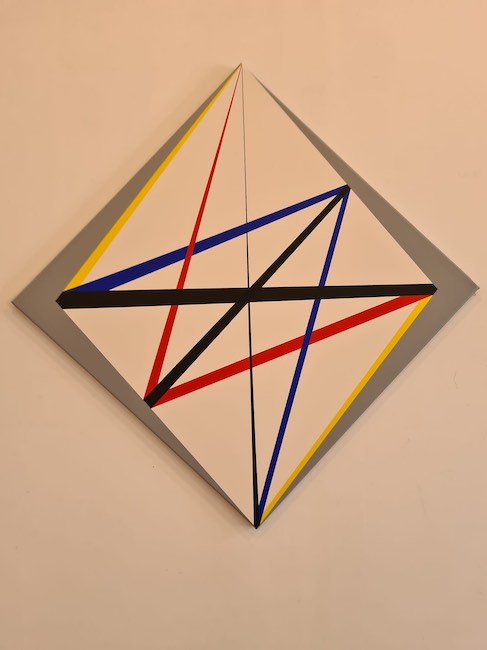
È stato quello il momento in cui ha messo in discussione tutto il percorso di apprendimento effettuato in precedenza, per avvicinarsi proprio all’Astrattismo Geometrico che, malgrado prenda grande ispirazione dal lavoro di Piet Mondrian, presenta caratteristiche inedite da cui fuoriesce anche la sua apertura nei confronti della vita e nelle sue sfaccettature probabilmente sperimentate a livello umano negli anni di lavoro con persone con disagi. In alcune opere prevale l’impronta De Stijl anche se solo dal punto di vista cromatico perché per quanto riguarda invece la geometricità Joseph Buis rompe gli schemi, adotta le linee in maniera prioritaria rispetto alle figure geometriche, e soprattutto interseca e intreccia i segni grafici come a sottolineare quella contrapposizione e sovrapposizione che si verifica costantemente nel corso dell’esistenza, un continuo incontro di individualità distinte ma per un istante legate le une alle altre.
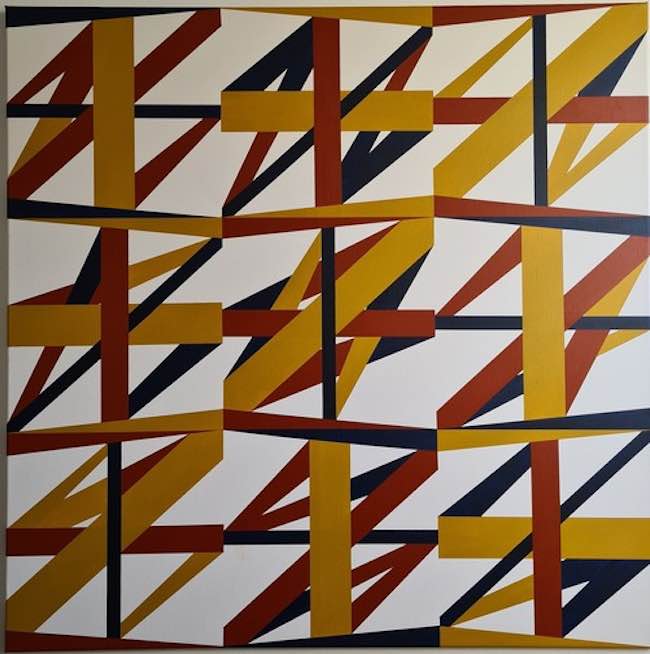
Persino lo spessore delle linee è eterogeneo, in alcuni casi inizia sottile per poi ingrossarsi, quasi come se ci si trovasse davanti alla metafora della vita, quel percorso in cui si parte quasi in maniera instabile, prendendo lentamente coscienza di sé e poi, nel corso del cammino, assume sostanza anche in virtù delle persone incontrate e delle esperienze vissute. In queste opere composte essenzialmente di linee su sfondo bianco, Buis aggiunge un elemento cromatico che rompe il rigore delle tonalità primarie e cioè il grigio, attraverso cui indica all’osservatore la possibilità di considerare le sfumature, i mezzitoni che anche in un approccio analitico e pragmatico di fatto sopraggiungono per suggerire una strada impensata e forse persino migliore.
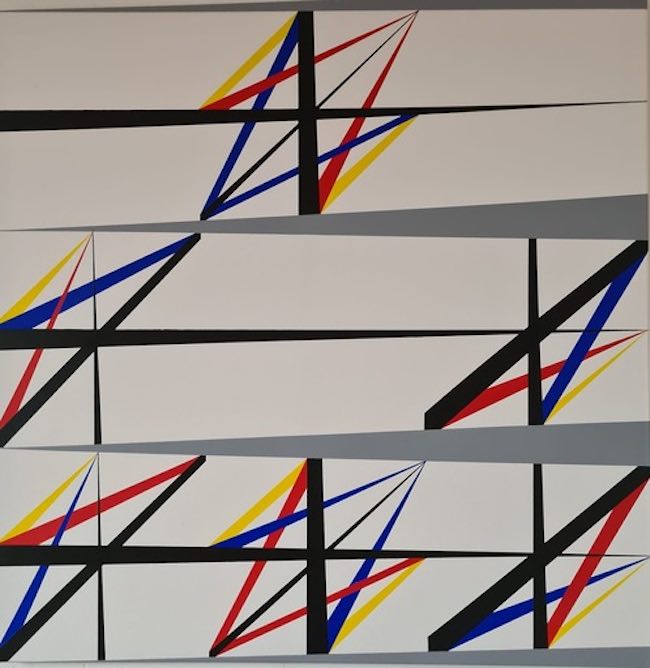
Dunque il rigore appartenente al De Stijl viene completamente attenuato e in qualche modo ammorbidito proprio in virtù della capacità dell’artista di suggerire quanto sia importante lasciarsi anche uno spazio per l’incognita, l’improvvisazione, l’imprevisto che può essere sì destabilizzante ma anche in fondo piacevolmente sorprendente senza necessariamente provocare una deviazione dai princìpi più saldi. La particolarità delle opere di Joseph Buis è che possono essere associate le une alle altre dando vita a polittici modulabili sulla base delle sensazioni suscitate oppure anche del messaggio che deve fuoriuscire dalla composizione, perché la condizione imprescindibile dell’apertura nei confronti di tutto ciò che fa parte dell’esistenza è la consapevolezza che un altro diverso dal sé può osservare ciascuna realtà da una posizione di osservazione differente, a volte persino opposta eppure altrettanto valida rispetto alla propria.
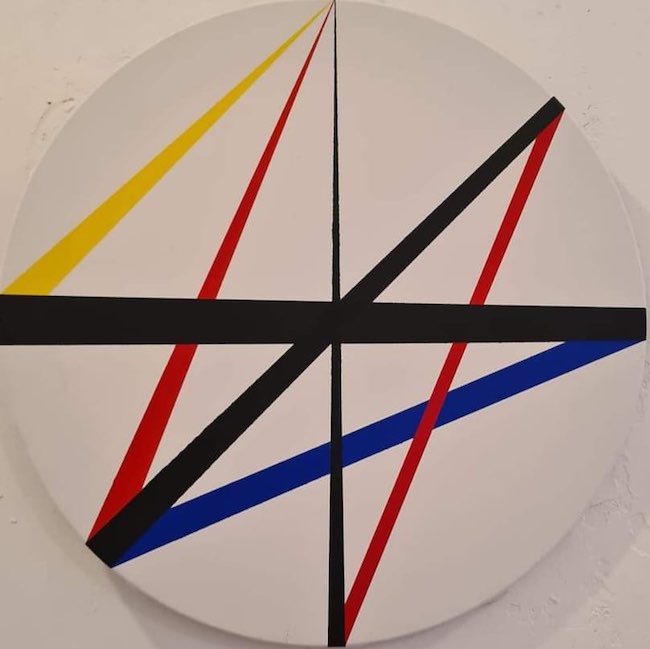
A questo intento creativo appartengono le opere della serie Untitled che mostrano l’eterogeneità con cui Joseph Buis affronta un tema univoco e tuttavia incredibilmente cangiante proprio grazie alle molteplici combinazioni e variazioni che vanno a comporre le differenti tele.
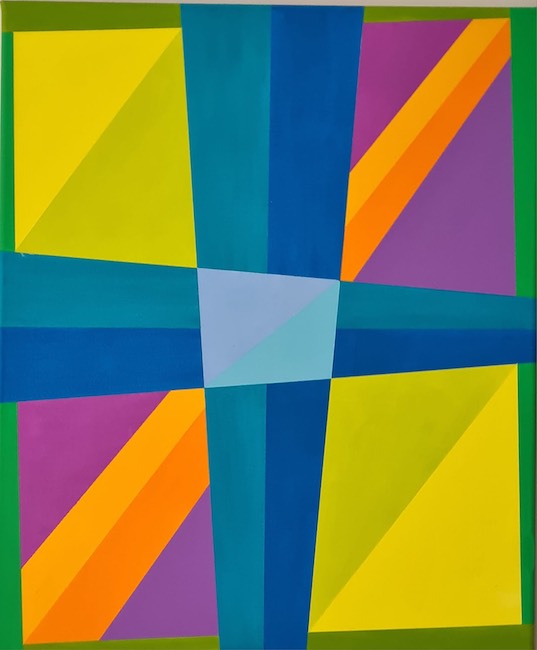
Ma l’artista ha anche un’altra anima, quella in cui abbraccia una gamma cromatica più ampia, più vivace, più intensa e solare, decisamente vicina alle divagazioni dell’Astrattismo Geometrico e del Cubismo Orfico dove ciò che predominava a volte sulla geometria e sul rigore delle forme narrate era quell’arcobaleno di colori a contrasto, fatto di tinte pastello oppure piene ed energiche attraverso le quali lasciar fuoriuscire un atteggiamento inedito, quello di chi ha attraversato e superato la razionalità, che però mai abbandona la natura stessa dell’essere umano, e ha deciso di intraprendere la strada dell’emotività che sopraggiunge a scardinare le certezze e a vivacizzare la quotidianità e che solo dopo un percorso di approfondita autoanalisi può sentirsi libera di fuoriuscire senza destabilizzare l’equilibrio acquisito. Nella serie di opere denominate Cross, e come le precedenti contrassegnate da numeri per distinguerle, le linee sono ingrandite rispetto alle Untitled, fino a diventare figure geometriche irregolari, rettangoli scaleni in cui Buis racchiude tutta l’energia dei colori, intensi, ombreggiati in alcuni particolari, e fortemente in contrasto gli uni con gli altri pur senza perdere la sensazione armonica che deriva proprio dal loro accostamento, come se l’artista volesse sottolineare quanto sia in virtù delle profonde differenze che è possibile arricchirsi reciprocamente.
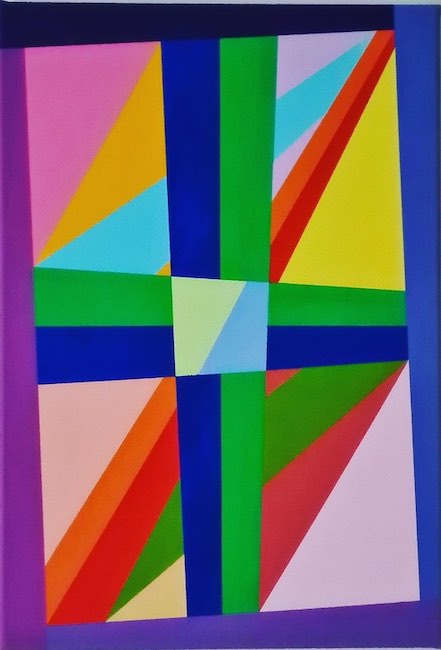
L’attraverso del titolo può essere inteso come l’oltrepassare un proprio limite, oppure il superare un ostacolo e andare oltre, o ancora vincere una sfida, da soli o insieme a qualcuno, tutte sensazioni positive che generano quel ventaglio cromatico che si armonizza con le emozioni provate; le forme principali, all’interno delle quali Joseph Buis ne nasconde altre secondarie, sono il rettangolo, il quadrato, il cerchio, nessuna geometricità è esclusa dalla ricerca mentale ma anche esistenziale dell’artista.
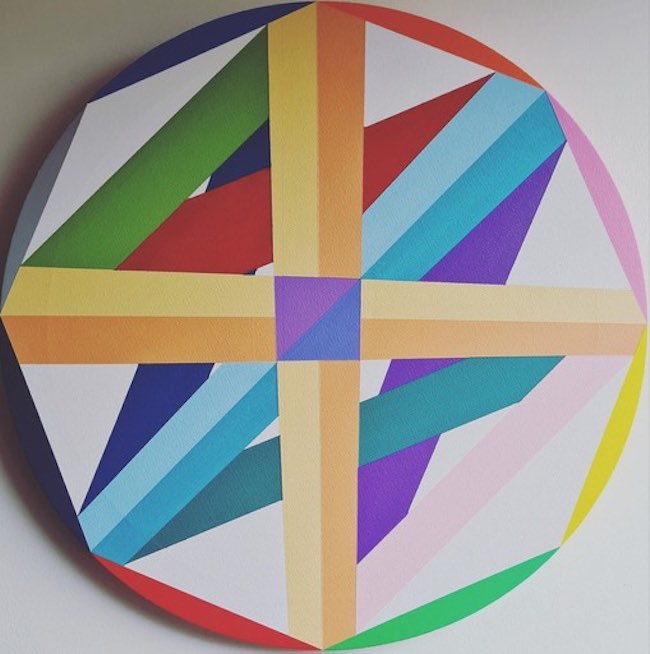
Joseph Buis ha al suo attivo la partecipazione a molte mostre collettive a Parigi, Milano, Roma, Brisbane (Australia) e Hünfeld in Germania, e personali in Francia e in Germania, dove affascina i visitatori per il suo stile geometrico e al tempo stesso decisamente poco rigido e per questo più coinvolgente.
JOSEPH BUIS-CONTATTI
Email: josephbuis55@gmail.com
Facebook: https://www.facebook.com/joseph.buis
Instagram: https://www.instagram.com/buisjosephartist/
The polyptychs of Joseph Buis’ Geometric Abstractionism, to experience the infinite combinations of reality
The multifacetedness of viewpoints and approaches to life and circumstances that follow one after the other, characterises contemporary society as much as the focus of observation of the artists who, within this existential mode, move in their own expressive research, indulging the style and language of painting and sculpture in the manner most akin to their way of conceiving the surrounding reality. Some show the need to detach themselves strongly from the observed in order to penetrate into a more rigorous world, almost more scientific, from which, however, cannot fail to emerge an open and positive nature which, precisely by virtue of that plastic purity, succeeds in highlighting all the softness of possibilism. The artist I am going to tell you about today belongs to this category of creatives.
The path of experimentation traversed by art during the first decades of the 20th century was marked by clear and well-defined separations between that group of artists who, while making conceptual changes, wished in some way to remain tied to figuration, to the observed possibly to be transcended in order to be indulged in the guidelines of the movements to which they belonged, and those who, on the contrary, emphasised the need to assert a superiority of the plastic gesture over any form that could be traced back to everyday reality and everything that the eye could grasp around it, thus leading to the courageous birth of all artistic currents that tended towards abstraction, the indefiniteness of forms and schematic rigour. Apart from a brief prelude with Vassily Kankinsky‘s Lyrical Abstractionism, whose emotive character would be taken up a few years later and expanded by the exponents of Abstract Expressionism, the tendency towards indefiniteness was the basis of movements such as Suprematism, whose founder Kazimir Malevic is also considered the forerunner and inspiration of the just later De Stijl. This movement born in Holland from the guidelines of its creator Piet Mondrian, assisted by Theo van Doesburg, took the geometricity of Suprematism to extremes and went so far as to accept only the shapes of the rectangle and square, straight horizontal and vertical lines, and primary colours.
The desire to give artistic expression priority over all new means of image reproduction such as photography and the emerging cinematograph, and the need to detach themselves from the atrocities of the First World War, which had been going on in neighbouring countries and which had deprived artists of the desire to draw inspiration from their surroundings, led the movement’s members to generate art as an end in itself, without emotions without references, to enter into the purity of the creative gesture. However, Mondrian‘s schematic nature and obstinacy in particular in not opening up to other forms such as the round and oblique line, soon became a limitation that induced other creatives inspired by and akin to the expressive concepts of De Stijl to found a new movement still linked to geometricity but more inclined to leave greater executive freedom to individual artists; that new movement took the name of Geometric Abstractionism and gave new life to a style that was fascinating for its rigour and almost scientific approach to the canvas, to which it introduced the possibility of both chromatic and formal interpretation by the individual executor of the artwork. The French artist Joseph Buis began his artistic career very early on, training as a self-taught artist but following the advice of masters he knew, who were happy to initiate him into the fascinating world of painting. However, his professional career as a specialist educator and art therapist for people with difficulties actually kept him away from his creative side to which he devoted himself after he retired. That was the moment when he questioned all the learning he had previously done, in order to approach Geometric Abstractionism, which, although it takes great inspiration from the work of Piet Mondrian, presents new characteristics from which also emerges his openness to life and its facets, probably experienced on a human level during the years of working with people with difficulties. In some artworks, the De Stijl imprint prevails, even if only from a chromatic point of view, because as far as geometricity is concerned, Joseph Buis breaks the mould, adopts lines as a priority over geometric figures, and above all intersects and intertwines the graphic signs as if to emphasise that juxtaposition and overlapping that constantly occurs in the course of existence, a continuous meeting of distinct individualities but for an instant linked to one another.
Even the thickness of the lines is heterogeneous, in some cases starting out thin and then becoming thicker, almost as if one were confronted with the metaphor of life, that journey in which one starts out almost unsteadily, slowly becoming aware of oneself and then, in the course of the journey, takes on substance also by virtue of the people met and the experiences lived. In these paintings composed essentially of lines on a white background, Buis adds a chromatic element that breaks the rigour of the primary tones, namely grey, through which he indicates to the observer the possibility of considering the nuances, the halftones that even in an analytical and pragmatic approach actually come to suggest an unthought-of and perhaps even better path. Thus, the rigour belonging to De Stijl is completely attenuated and in some ways softened precisely because of the artist’s ability to suggest how important it is to leave room for the unknown, improvisation and the unexpected, which can be destabilising but also pleasantly surprising without necessarily causing a deviation from the firmest principles. The peculiarity of Joseph Buis‘s artworks is that they can be associated with each other to create polyptychs that can be modulated on the basis of the sensations aroused or even the message that is to come out of the composition, because the indispensable condition for openness towards everything that is part of existence is the awareness that another person other than oneself can observe each reality from a different observation position, sometimes even opposite and yet just as valid as one’s own. The artworks in the Untitled series belong to this creative intent, they show the heterogeneity with which Joseph Buis tackles a univocal and yet incredibly iridescent theme thanks to the multiple combinations and variations that make up the different canvases. But the artist also has another soul, one in which he embraces a broader, more lively, more intense and sunny range of colours, decidedly close to the digressions of Geometric Abstractionism and Orphic Cubism where what sometimes predominated over the geometry and rigour of the forms narrated was that rainbow of contrasting colours, made up of pastel or full and energetic hues through which he let emerge an unprecedented attitude, that of someone who has crossed and surpassed rationality, which, however, never abandons the very nature of the human being, and has decided to take the path of the emotionality that comes to unhinge certainties and enliven everyday life and that only after a path of in-depth self-analysis can feel free to escape without destabilising the acquired balance. In the series of paintings called Cross, and like the previous ones marked by numbers to distinguish them, the lines are enlarged with respect to the Untitled, until they become irregular geometric figures, scalene rectangles in which Buis encloses all the energy of the colours, intense, shaded in some details, and strongly contrasting with each other without losing the harmonic sensation that derives precisely from their juxtaposition, as if the artist wanted to emphasise how it is by virtue of the profound differences that it is possible to enrich each other. The through of the title can be understood as going beyond one’s own limit, or overcoming an obstacle and going further, or even win a challenge, alone or together with someone else, all positive sensations that generate that chromatic range that harmonises with the emotions felt; the main shapes, within which Joseph Buis conceals other secondary ones, are the rectangle, the square, the circle, no geometricity is excluded from the artist’s mental but also existential research. Joseph Buis has taken part in many group exhibitions in Paris, Milan, Rome, Brisbane (Australia) and Hünfeld in Germany, and solo exhibitions in France and Germany, where he fascinates visitors with his geometric and at the same time decidedly unstrict and therefore more engaging style.


